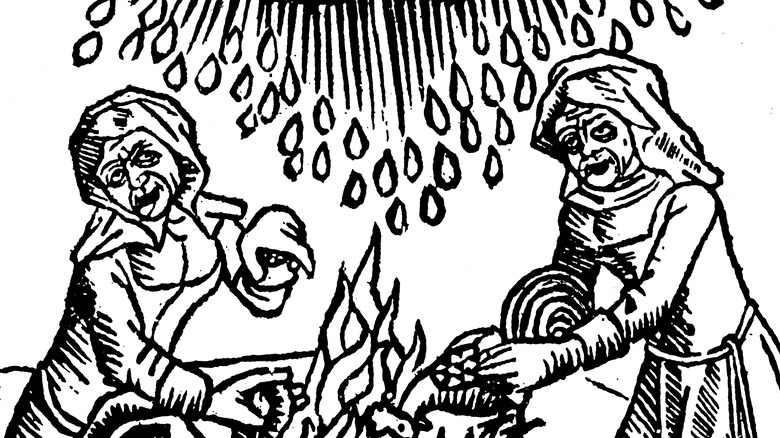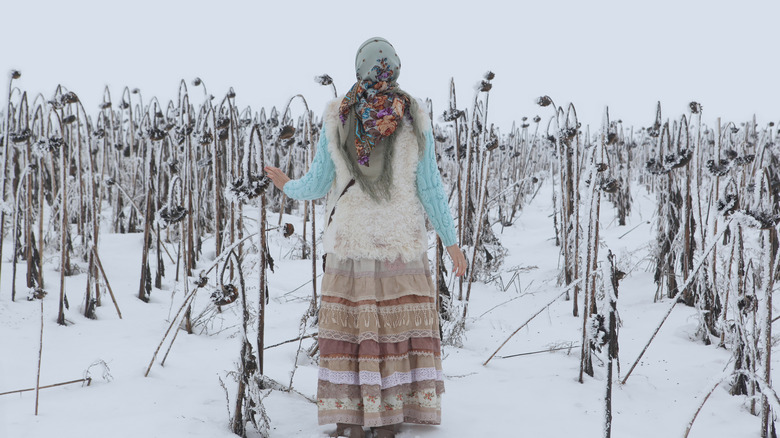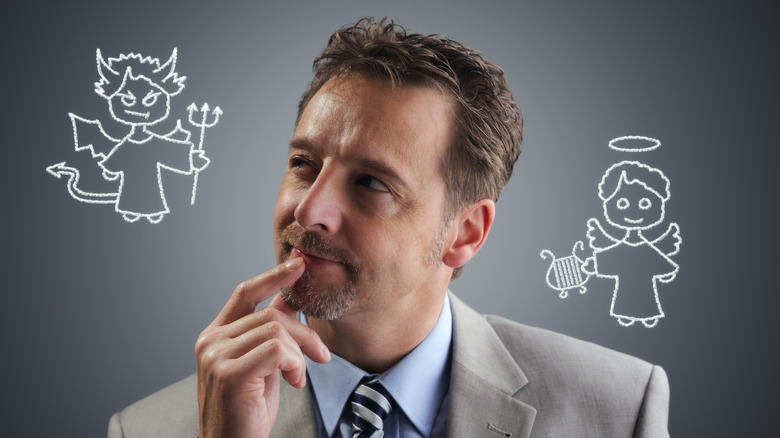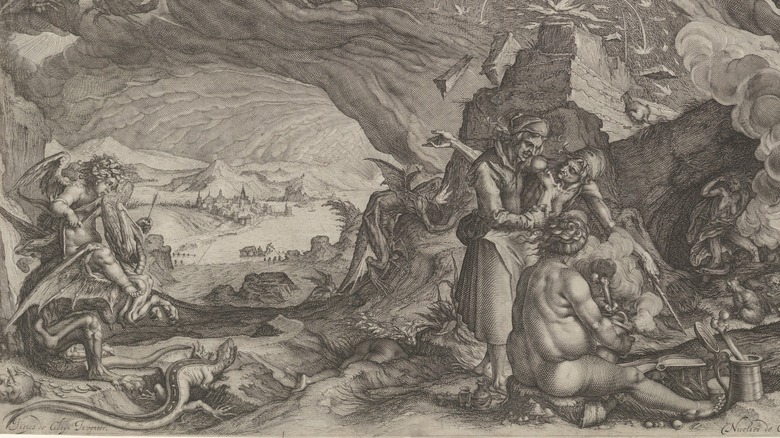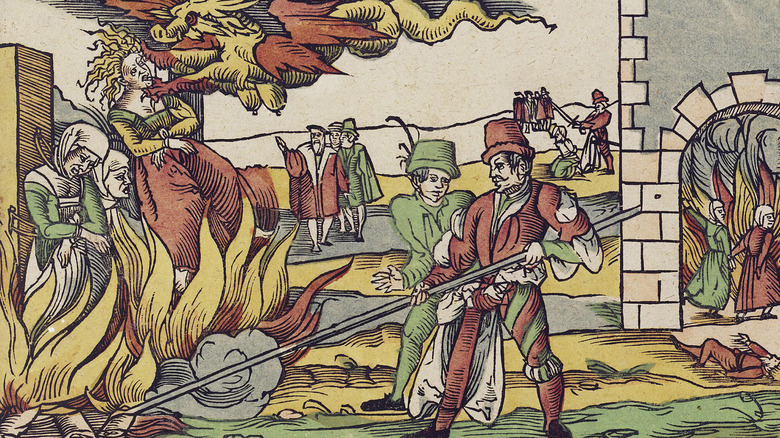Europe's Biggest Witch Trial In Their History That You Probably Never Heard About
Historians refrain from calling it The Dark Ages anymore because it's considered a value judgment (via Britannica). But given the horrendous weather, food shortages, ecclesiastic turmoil, and endemic economic strife, it's hard to put 16th century central Europe on one's list of time-travel destinations (via Climatic Change).
The broadsheets of mid-16th century southern Germany reported never-ending meteorological disasters as well as their destructive effects on the health and well-being of rural populations. Going into the 1580s, huge crop failures and price increases led to hunger and miserable living conditions across central Europe. Desperate for an end to their ill fortune, the people grasped for both explanations and solutions (via 2003's "Witch Hunts in Europe and America: An Encyclopedia"). Some Lutheran, Catholic, and Calvinist authorities tried to reassure everybody that this was all the people's fault for angering God. Yet, a series of illogical doctrines and cultural beliefs led other church authorities to identify the obvious cause of these bad times: witches.
The German lands of The Holy Roman Empire harbored the sites of the most ferocious witch hunts and executions in central Europe. As the "great fear" reached a fever pitch in the 1580s, persecutions grew in frequency. The dreadful events of the Great Persecution of 1587-1594 in the diocese — the ecclesiastical territory — of Trier, Germany, was a perfect storm of theocratic idiocy, evil men, a decentralized government, and a climatic event called The Little Ice Age.
We're in trouble because a changing climate equals more witches, somehow
Before the 1400s, the Catholic Church did not acknowledge witches existed. But then in 1486, the book "Malleus Maleficarum," or the "Witches Hammer," canonized regional folklore of witch activities. The text was written by two Catholic priests and became the authority not just on witches but how to conduct witch trials (via Britannica). Early modern European witches supposedly indulged in Satanic pacts, sabbat celebrations, infanticide, human-demon sex, and, most importantly, maleficia, or evil acts against another (via "Witch Hunts in Europe and America: An Encyclopedia"). Eventually, Protestants embraced the "Malleus Maleficarum" as well.
Of the many fake things that non-existent witches were capable of, an article in the journal Climatic Change argues the charge that caused the most fervent persecutions was controlling the weather, or weather-making. "Malleus Maleficarum” specifically purported that "unnatural" meteorological events, such as hailstorms, were conjured via witchcraft.
Unlike other evil actions, changes in the weather had the potential to affect the whole community. A small, unnatural, personal tragedy could lead to a single accusation, but large storms causing the loss of crops and epidemics could bristle an entire community into demands for retribution and hunts for those responsible. Since the church and government were pretty much the same thing, weather-making was designated a crime in the mid 1400s. All of this occurred right in time for Europe to go through a climatic event called the Little Ice Age.
Little ice age causes little deaths literally everywhere
Climatologists believe a weather phenomenon called the Little Ice Age changed the temperatures and rainfall in Europe between the 1300s and 1600s (via Climatic Change). Various campaigns and persecutions against fake-witches can be tied to specific spikes in cold or extreme weather. Even disparate locations with little to no contact with one another saw similar violent trends along with shared weather phenomena.
Extreme climatic events and metaphysical cultural beliefs really came together and doomed the Trier region of Germany in the 1580s. As a cold glacial advance crept into the region, Trier's grain and wine stocks were hit hard by the increased rainfall, low temperatures, hailstorms, and shortened growing seasons (via "Witch Hunts in Europe and America: An Encyclopedia"). In 1586, a series of wet and cold springs and summers began. The year 1587 saw snow on the ground until spring and again in July and September. Then, to top it all off, 1588 was the rainiest year in history, featuring violent thunderstorms. Mismanagement and lack of agricultural diversity left crops more vulnerable to the extreme weather. Fueled by the ecclesiastical authorities, the search for maleficent witches by a "hangry" populace increased during bad weather and low crop yields.
Best selling book kills tens of thousands
Johann von Schöneburg was the archbishop of Trier from 1581 to 1599 (via Executed Today). Faced with decimation of both crops and living conditions, the archbishop proceeded to make things a lot worse. To show his love for the Jesuits, Archbishop Schöneburg purged his diocese of Protestants, Jews, and non-existent witches (via Witchcraft and Witches). The witch hunt campaigns and large mass executions were very popular and won political points against the up-and-coming Protestants. Skeptics were treated harshly, which allowed the extreme nature of these persecutions to continue.
Archbishop Schöneburg's lackey was Peter Binsfeld, a witch-hunter, demonologist, and a natural at making the dark ages darker (via "Witch Hunts in Europe and America: An Encyclopedia"). In his book "Treatise on the Confessions of Evildoers and Witches," Binsfeld developed a bunch of arbitrary rules on imaginary things.
The treatise was soft on torture. It suggested the Holy Roman Empire loosen torture restrictions, because it's okay to torture witches for their confessions. After all, acts of witchcraft were "crimes of exception." Next, witchcraft trials can toss out those rules about children and parents not testifying against one another. Now children could not only give testimony but be convicted themselves of being witches. Finally, in perhaps the first instance of a now classic plot device, contrasting with our guardian angel, Binsfeld said everyone also had their own personal demon, hell-bent on leading them to witchcraft.
Oh, no, a rich man is in trouble!
Fear swept the lands, including nobles and commoners alike (via "Witchcraft in Europe"). More so than other witch hunts, those in Trier affected the social elite (via "Witch Hunts in Europe and America: An Encyclopedia"). The accused and executed included parish priests, judges, councilors, and rural deans. Occasionally, the trials acted as a way for the poor to demonstrate resentment against more prosperous community members. At times it seemed the severe judicial actions only benefited the executioners, who now rode thoroughbred horses and adorned themselves with gold and silver.
When Archbishop Von Schöneburg fell ill in 1587, an 8-year-old boy confessed that this malady was part of a magical plot and implicated the dean of the Law Faculty at the University of Trier, Dietrick Flade. Flade had become politically isolated by going easy on humans accused of being witches and those involved in that pesky reformation (via Executed Today). At first, accusations were ignored due to Flade's rank, but the number of accusations grew. Twenty-three rural people tortured into confessions from surrounding villages claimed to have seen Flade at local sabbats. After a failed attempt to flee the region, Flade's political trial received a huge amount of public attention. He suffered through five intense torture sessions until he confessed and was sentenced to burning, with preliminary strangulation, in 1589.
Witch burnings look suspiciously like people burnings
Despite the newsworthy deaths of noblemen, most of the victims were poor, old, rural women (via "Witch Hunts in Europe and America: An Encyclopedia"). It just so happened that witches tended to be women who weren't subservient to male authority figures. By 1593, some towns were left with few remaining women and too few workers, leading to an economic crisis that lasted for decades (via Climatic Change).
Of all the German territories in the 1500s, the Great Persecution of Trier had the largest fake-witch body count. Over 350 human burnings occurred as a result of tortured confessions between 1581 and 1595 (via Executed Today). The Trier territory of Quedlinburg saw the burning of 133 in a single day. Decentralized power structures of small towns let persecutions continue unchecked by outside authorities. The lack of central judicial supervision allowed for the free implementation of torture. German torture was particularly renowned for its inventive ways to inflict pain and tender confessions.
In the late 1620s, dedicated civil services hunted witches, ran special prisons, commissions, and recruited traveling demonologists. But the social tensions created were unsustainable, and with a positive change in the weather, the 1630s saw witch persecutions begin to subside.

